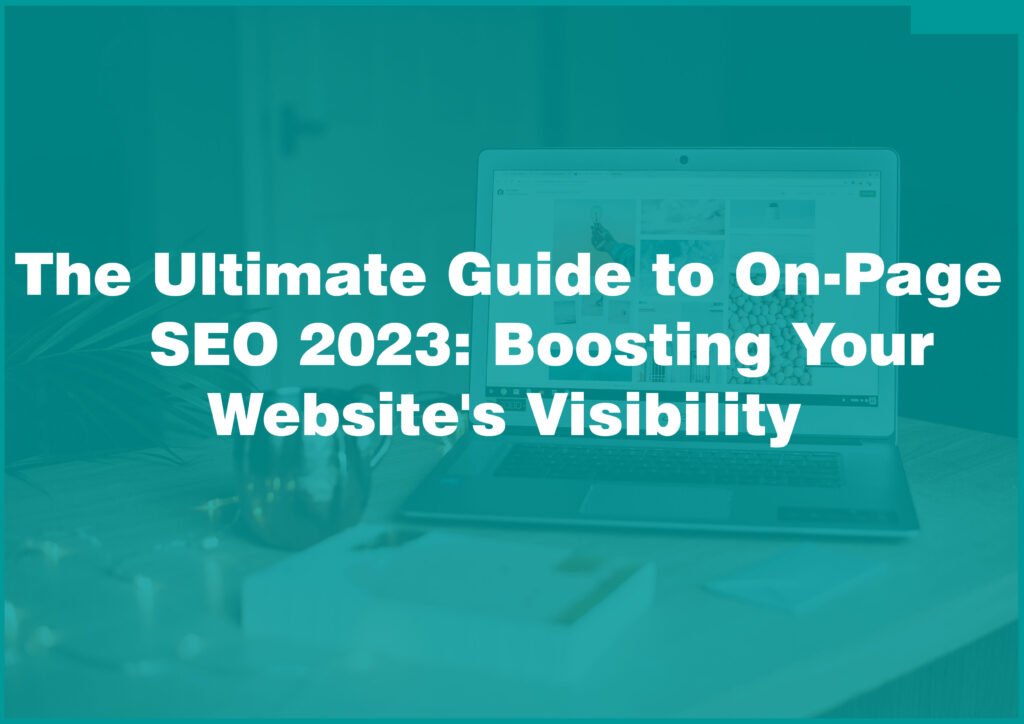
Greetings, and thank you for visiting the definitive resource on on-page SEO! In this extensive essay, I’ll go through various tactics that may boost your site’s position on search engine results pages. The value of on-page SEO must be balanced, whether you are an experienced digital marketer or a business owner trying to improve your company’s online exposure. So, let’s get right in and discover the keys to increasing your website’s traffic!
What is On-Page SEO?
It might use on-page SEO strategies to boost a site’s exposure and search engine ranks, which are changes made directly to the site. Search engine optimization (SEO) enhances a website’s visibility and usability in search results by adjusting numerous on-page factors. Improvements in UX, organic traffic, and sales may all result from a concentrated effort on individual page SEO.
Why is On-Page SEO Important?
On-page optimization is essential for search engines to comprehend your website’s content and function. Websites understood by search engines and relevant to user queries tend to perform better in search engine rankings. To maximize the benefits of organic traffic, on-page SEO should be an integral part of any comprehensive digital marketing plan.
Key Elements of On-Page SEO
Title Tags
A page’s title is specified via title tags and HTML elements. Because they serve as clickable headlines in search engine results, they are an essential part of on-page SEO. Use important keywords while maintaining brevity and detail in your title tags to improve your SEO. Aim for 50-60 characters at most to prevent having your description truncated.
Meta-Descriptions
You might think of meta descriptions as mini-summaries of a page’s content. While they have no bearing on organic search results, they may significantly affect click-through rates. Use an accurate summary of the page’s content and relevant keywords to create engaging meta descriptions to encourage readers to click on your link.
URL Structure
When a URL is well-organized, it benefits both users and search engines. Always aim for brevity, clarity, and readability when crafting URLs. Only use cryptic or excessively long URLs that explain what the website is about.
Header Tags
Your content’s headers and subheadings may be organized with the help of header tags (H1, H2, H3, etc.) in the HTML code. They aid crawlers in figuring out the structure of your site and its content. Use header tags to indicate the content’s subject and importance by including relevant keywords.
Keyword Optimization
On-page search engine optimization relies heavily on keywords. If you want to know which keywords will bring you the most significant traffic and sales, you need to do some research. Use these terms organically in your writing, especially in section headers, body copy, and picture alt text. Avoid using too many keywords to avoid a drop in search engine ranks.
Content Quality and Relevance
On-page search engine optimization relies heavily on high-quality, relevant content. Produce original, helpful, and exciting material that answers the questions of your intended readers. To position yourself as an expert in your field, your material should be beneficial to readers by answering their questions and resolving their issues.
Internal and External Linking
A page’s on-site SEO relies heavily on its internal and external links. When search engines scan and index your site, they will have an easier time doing so if there are internal connections between the pages. Users will appreciate your added value by linking to authoritative and relevant websites.
Image Optimization
Including images on your website may increase its aesthetic appeal and attract more visitors. Use descriptive file names, reduce file sizes, and add alt text to your photographs to improve quality. Including descriptive alt text with your photos might increase their visibility in search engine results pages (especially in image searches).
User Experience
In on-page SEO, user experience plays a key role. Ensure anybody can access and navigate your website and that it loads promptly. The key to offering a good user experience is a combination of a straightforward site structure, clear calls to action, and mobile-friendliness.
Mobile-Friendliness
Considering how widespread the usage of smartphones and tablets has become, updating your website to make it mobile-friendly is essential. If you want mobile consumers to have a positive experience on your site, you must ensure it works well with their devices. Search engines use mobile-friendliness to signal how high to place a page in the results.
Page Load Speed
When it comes to on-page SEO, page load speed is paramount. Users have come to anticipate instant page loads, and search engines have prioritized it to meet this demand. To make your websites load fast, compress pictures, decrease code, use browser caching, and use a reputable hosting service.
Schema Markup
Schema markup is structured data that may be added to the HTML of a website to improve how well search engines crawl and index its content. Implementing schema markup might increase a website’s position in search engine results and, by extension, the number of clicks it receives.
Social Sharing
Likes, shares, and comments from social media may have a knock-on effect on how popular your website becomes. Add sharing buttons to your website and focus on making material that will connect with your target audience so they will want to share it with their social networks.
Site Security
Website security is crucial to keep your data and users’ confidence intact. Ensure your website’s users can communicate safely using HTTPS and SSL certificates. Websites with solid security measures tend to perform better in search results.
User Engagement Metrics
Site performance may be better understood by analyzing user engagement indicators like bounce rate, time on page, and click-through rate. Monitor these KPIs and make changes to boost user engagement and happiness.
Readability and Formatting
Content that is easy to scan and navigate will keep readers interested and increase the likelihood that they will return to your site. Divide your text into paragraphs, utilize bullet points, and style it correctly using bold and italics to make it easier to read.
Canonical Tags
When a website has duplicate material, canonical tags tell search engines which version to prioritize. It would help if you used canonical tags to minimize exact content problems and consolidate link equity.
XML Sitemap
With an XML sitemap, search engines can more easily find and index all your site’s pages. If you want all of the pages on your site to be scanned and indexed, you should send out an XML sitemap to search engines.
Robots.txt
To direct search engine crawlers to just the sites you want to be indexed, use a robots.txt file. A robots.txt file allows you to specify which parts of your website are accessible to search engines.
HTTPS and SSL
Implementing HTTPS and SSL encryption will secure your users’ browsing sessions. Switching to HTTPS for your website is crucial for higher search engine results.
Breadcrumbs
Breadcrumbs provide a hierarchy of links that visitors may follow to understand better where they are on your site. The organization of your site is made more apparent to search engines thanks to them.
Alt Text for Images
Using alternative text (alt text) helps search engines and visually challenged individuals better understand what a picture is about. Use accurate alt text to increase an image’s visibility in search results.
Video Optimization
Add a video to your website to make the material much more engaging. Add transcripts, descriptive descriptions, and relevant keywords to your videos to boost their rankings in search results.
Geo-Targeting
Using geo-targeting techniques would help reach customers in your company’s area. You should tailor your website and content to include related keywords to attract clients in a specific area.
Structured Data
If you want search engines to understand the content of your web pages better, use structured data markup. If you want your sites to show up with rich snippets and other elements in search engine results, you should use structured data.
Conclusion
Congratulations! The complete on-page SEO guide is finished. This post will teach you how to optimize your website to perform better in search engine results, receive more organic traffic, and provide a more satisfying experience for visitors. Keeping up with the ever-changing search engine algorithms requires constant monitoring and adjusting your on-page SEO. Incorporate these strategies immediately to see a dramatic increase in traffic to your site.





